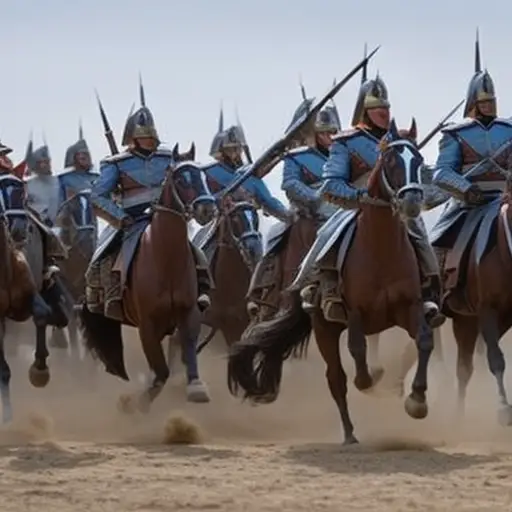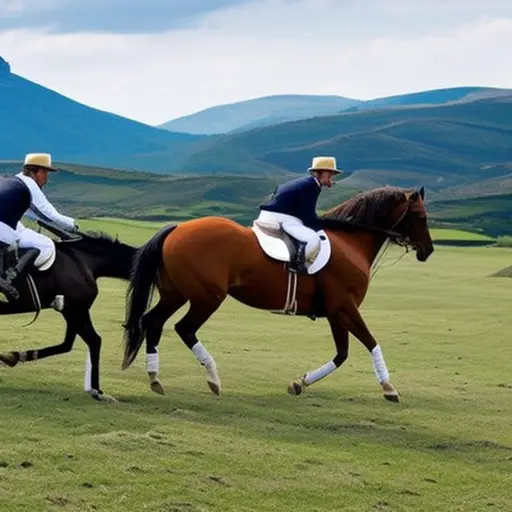The Influence of Horsemanship on Military Tactics and Strategies

Do you ever wonder how horsemanship has shaped military tactics and strategies throughout history?
From ancient warfare to modern military strategies, the influence of horsemanship cannot be underestimated. Mounted archers, knights, and even contemporary horse soldiers have all relied on their mastery of horsemanship to gain an advantage on the battlefield.
In this article, we will explore the significance of cavalry charges, the role of horsemanship in different historical periods, and how it continues to shape contemporary warfare.
Evolution of Cavalry Warfare
You’ll be amazed at the impact the introduction of gunpowder had on the evolution of cavalry warfare. The evolution of horse breeds played a significant role in shaping the tactics and strategies of cavalry units throughout history. As gunpowder began to revolutionize warfare, horses were bred for specific purposes, such as speed, endurance, and maneuverability. This evolution of horse breeds allowed cavalry units to adapt to the changing battlefield conditions and become even more effective in combat.
The impact on logistics was another crucial aspect of the evolution of cavalry warfare. With the introduction of gunpowder weapons, cavalry units needed to be supported by a complex system of supply and transportation. Horses required food, water, and medical care, and these logistics became even more important as the speed and range of cavalry operations increased. The ability to efficiently supply and maintain cavalry units became a critical factor in their success on the battlefield.
The evolution of cavalry warfare brought about significant changes in the way battles were fought. The introduction of gunpowder weapons and the development of specialized horse breeds transformed cavalry units into highly mobile and versatile forces. These changes not only impacted the tactics and strategies employed by cavalry units but also had a profound influence on the overall conduct of warfare.
The evolution of cavalry warfare was a testament to the adaptability and innovation of military forces throughout history.
The Role of Horsemanship in Ancient Warfare
Ancient warriors relied heavily on their expert horsemanship skills to gain a decisive advantage on the battlefield. The role of horses in ancient warfare was crucial, and cavalry charges played a significant part in shaping the outcome of battles.
Here are three key reasons why horsemanship was essential in ancient warfare:
-
Speed and mobility: Horses provided warriors with unmatched speed and agility on the battlefield. Cavalry units could swiftly maneuver across the terrain, allowing them to outflank and surprise their enemies. This mobility gave them the ability to launch devastating attacks and retreat quickly when needed.
-
Shock and intimidation: The sheer force and size of a charging cavalry unit were enough to instill fear in the hearts of the enemy. The thunderous sound of hooves and the sight of horsemen charging at full speed created a psychological impact, often causing the opposing forces to break ranks and flee.
-
Versatility and flexibility: Horses provided warriors with versatility in combat. They could engage in both ranged and melee attacks, making them effective against various types of enemy units. Cavalry units could quickly switch between roles, from scouting and skirmishing to charging head-on into enemy lines.
The importance of cavalry charges can’t be overstated in ancient warfare. They were instrumental in breaking enemy formations, disrupting their lines, and creating chaos. Skilled horsemanship allowed ancient warriors to exploit these advantages, often leading to decisive victories on the battlefield.
Impact of Mounted Archers on Military Tactics
Mounted archers not only provided valuable long-range firepower, but they also offered strategic versatility on the battlefield. The evolution of horse archery played a significant role in shaping military tactics and strategies throughout history. The use of mounted archers can be traced back to ancient civilizations such as the Scythians, Parthians, and Mongols. These skilled horsemen revolutionized warfare by combining the mobility of the horse with the deadly accuracy of the bow.
The strategic use of mounted archers allowed armies to engage the enemy from a safe distance while maintaining mobility. They could rain down a hail of arrows on their opponents, causing chaos and confusion among the enemy ranks. This tactic was particularly effective against infantry formations that relied on close combat. The ability to quickly maneuver on horseback gave mounted archers the advantage of surprise, enabling them to strike and retreat before the enemy could counterattack.
Mounted archers also played a crucial role in scouting and reconnaissance. Their speed and agility allowed them to cover vast distances and gather vital information about enemy positions, terrain, and supply lines. This intelligence was instrumental in shaping military strategies and determining the best course of action.
Knights and Chivalry: The Influence of Horsemanship in Medieval Warfare
Knights and chivalry played a significant role in medieval warfare. Utilizing their exceptional horsemanship, they were able to gain a distinct advantage on the battlefield. Mounted warriors were able to maneuver swiftly and strike with force, disrupting enemy formations and creating chaos. Their ability to charge with speed and precision not only impacted the dynamics of the battlefield but also instilled fear in their opponents, further enhancing their military effectiveness.
Mounted Warriors’ Advantage
You can’t deny the significant impact that cavalry had on medieval warfare. The advantages of cavalry, particularly horse-mounted warriors, were undeniable. Here are three key reasons why:
-
Mobility: Cavalry provided unparalleled speed and maneuverability on the battlefield, allowing them to quickly outflank and overwhelm enemy forces. They could cover large distances in a short amount of time, providing a tactical advantage in both offense and defense.
-
Shock Value: The sheer force and impact of a cavalry charge were enough to instill fear and panic in the enemy ranks. The sight of heavily armored knights charging towards them on horseback was a terrifying spectacle that often broke enemy formations, leading to disarray and chaos.
-
Versatility: Cavalry was versatile in its capabilities. They could engage in melee combat with their lances, swords, and maces, or utilize ranged weapons like bows and crossbows. This allowed them to adapt to different situations and engage in various types of warfare, whether it be charging head-on or harassing enemy forces from a distance.
The advantages of cavalry made them an essential component of medieval warfare, shaping the tactics and strategies of the time.
Impact on Battlefield Dynamics
No one could deny the profound impact that horsemanship had on the dynamics of the battlefield during medieval warfare. The tactical maneuverability provided by skilled horsemen gave their armies a significant advantage.
Mounted warriors were able to swiftly navigate the terrain, making it easier to outmaneuver their opponents and launch surprise attacks. The ability to quickly traverse the battlefield allowed for efficient communication and coordination between different units, enhancing the overall effectiveness of the army.
In addition, mounted reconnaissance was a crucial component of medieval warfare. Riders could scout enemy positions, gather intelligence, and relay vital information back to their commanders. This allowed for better decision-making and strategic planning.
The combination of tactical maneuverability and mounted reconnaissance made horsemanship a crucial factor in shaping the outcome of battles during this period.
Horse Soldiers: Horsemanship in Modern Military Strategies
During combat, horse soldiers play a crucial role in maneuvering through difficult terrain and engaging with enemy forces. In modern military tactics, the use of horse soldiers has evolved to adapt to the changing nature of warfare. Here are three key ways in which horsemanship continues to shape modern military strategies:
-
Rapid Mobility: Horse soldiers provide a unique advantage in terms of speed and agility on the battlefield. With their ability to navigate rough terrains, such as mountains or dense forests, they can quickly move troops and supplies, outmaneuvering the enemy. This allows for swift response times and the ability to strike at vulnerable points.
-
Reconnaissance and Surveillance: The use of horse soldiers for reconnaissance and surveillance purposes remains critical in modern military operations. Equipped with the necessary technology, such as night vision goggles and communication devices, horse soldiers can gather valuable intelligence on enemy movements and relay information in real-time. This information is vital for commanders to make informed decisions and gain a tactical advantage.
-
Psychological Impact: The presence of horse soldiers on the battlefield can have a significant psychological impact on both friendly and enemy forces. The sight of a mounted soldier charging at full speed can instill fear and confusion in the enemy ranks, disrupting their formations and morale. Additionally, horse soldiers can serve as a symbol of strength, tradition, and national identity, boosting the morale of friendly forces and inspiring them to fight with determination.
The Significance of Cavalry Charges in Military History
Cavalry charges have played a significant role in military history, impacting battlefield outcomes and shaping tactical advantages and disadvantages.
The ability of cavalry units to swiftly engage and disengage from enemy forces provided a unique advantage, allowing for quick and decisive maneuvers.
However, the evolution of warfare and the introduction of new technologies have also posed challenges to cavalry tactics, necessitating adaptations in order to remain effective on the battlefield.
Impact on Battlefield Outcomes
You often underestimate the impact of cavalry charges on battlefield outcomes throughout military history. The influence of horsemanship on military tactics and strategies is evident in the significance of cavalry charges. Here are three key reasons why cavalry charges have had a significant impact on battlefield outcomes:
-
Battlefield communication: Cavalry charges allowed for quick and efficient communication between different units on the battlefield. The speed and mobility of cavalry units enabled them to relay important messages and coordinate attacks, giving commanders a tactical advantage.
-
Strategic mobility: Cavalry charges provided armies with the ability to move rapidly across the battlefield, allowing them to exploit weaknesses in enemy lines or launch surprise attacks. This strategic mobility often caught opposing forces off guard, disrupting their formations and causing chaos on the battlefield.
-
Psychological impact: The sight and sound of a charging cavalry unit instilled fear and panic in enemy soldiers. The thundering hooves, the glint of weapons, and the sheer force of a cavalry charge created a psychological shock that often broke the enemy’s morale and led to their disintegration.
Considering these factors, it’s clear that cavalry charges played a crucial role in shaping battlefield outcomes throughout military history.
Tactical Advantages and Disadvantages
One of the key advantages of cavalry charges in military history is that they provided a swift and overwhelming force on the battlefield. The speed and power of a cavalry charge could quickly break enemy lines, create chaos, and demoralize the opposing forces. Cavalry units were often used to exploit weaknesses in the enemy’s defenses, launch surprise attacks, and pursue retreating forces. However, there were also disadvantages to relying heavily on cavalry charges. For one, cavalry units were vulnerable to certain types of terrain, such as dense forests or steep hills, which limited their effectiveness. Moreover, the cost of maintaining and training cavalry units was often high, and their mobility and speed could be hindered by adverse weather conditions. Despite these drawbacks, well-executed cavalry charges played a significant role in shaping the outcomes of many battles throughout history.
| Tactical Advantages | Tactical Disadvantages |
|---|---|
| Swift and overwhelming force | Vulnerable in certain terrains |
| Breaks enemy lines effectively | High cost of maintenance and training |
| Creates chaos and demoralizes the enemy | Limited mobility in adverse weather conditions |
| Exploits weaknesses in enemy defenses | Can be countered by well-prepared infantry |
| Launches surprise attacks and pursues retreating forces | Requires skilled horsemanship and coordination |
Evolution of Cavalry Tactics
With the development of new weaponry and changing battlefield conditions, cavalry charges became increasingly adapted to suit the evolving demands of warfare. The evolution of horse breeds played a significant role in the effectiveness of cavalry tactics.
Horses were selectively bred for speed, agility, and endurance, allowing them to carry heavily armored knights into battle. Training techniques for cavalry also evolved, focusing on developing the horse’s obedience and responsiveness to the rider’s commands. This included teaching the horse to charge in formation, maintain a steady pace, and execute precise maneuvers.
Additionally, cavalry units began to incorporate more specialized roles, such as light cavalry for reconnaissance and heavy cavalry for shock assaults. These developments in cavalry tactics allowed for greater flexibility and effectiveness on the battlefield.
Adaptation and Innovation: Horsemanship in Contemporary Warfare
Modern militaries have recognized the invaluable role of horsemanship in shaping contemporary warfare. Horsemanship has adapted and evolved to meet the changing demands of modern combat. One of the key adaptation strategies has been the integration of horses into specialized units such as the Special Forces.
These units use horses to navigate difficult terrains where vehicles are impractical. Horses provide stealth and maneuverability, allowing soldiers to move swiftly and silently, avoiding detection by the enemy. Additionally, horsemanship plays a crucial role in reconnaissance missions. Horses have a keen sense of danger and can detect threats that may be missed by technology or human scouts. They’re also able to traverse rugged and mountainous landscapes, providing access to areas where traditional vehicles would be unable to operate.
Furthermore, horsemanship has found a place in ceremonial and symbolic roles within modern militaries. The use of horses in parades and military displays not only pays homage to tradition but also showcases the strength and discipline of the military.
Frequently Asked Questions
How Did the Evolution of Cavalry Warfare Impact the Development of Military Tactics and Strategies?
The evolution of cavalry warfare significantly impacted the development of military tactics and strategies. Mounted archers, in particular, had a profound influence on specific historical periods, shaping the way ancient armies approached and engaged in combat.
What Were the Key Roles of Horsemanship in Ancient Warfare and How Did They Shape Military Tactics?
In ancient warfare, horsemanship played a crucial role in shaping military tactics. The importance of cavalry tactics cannot be overstated, as they provided speed, mobility, and the ability to flank the enemy. Additionally, the impact of Mongol horse archers revolutionized warfare.
How Did the Use of Mounted Archers Influence Military Tactics and Strategies During Specific Historical Periods?
Mounted archers had a significant impact on ancient military tactics. Their ability to shoot arrows while on horseback allowed for greater mobility and flexibility on the battlefield, influencing strategies and shaping the course of medieval warfare.
What Were the Contributions of Knights and Chivalry to Medieval Warfare, and How Did Horsemanship Play a Role in Their Military Strategies?
In medieval warfare, knights and chivalry played a vital role. The skill of horsemanship influenced their military strategies, granting them mobility and power on the battlefield. Let’s dive into their contributions and the impact of horsemanship.
How Has Horsemanship Been Incorporated Into Modern Military Strategies and What Are Some Examples of Its Significance in Contemporary Warfare?
Incorporation of cavalry and modern military applications is significant in contemporary warfare. It allows for increased mobility, reconnaissance, and shock value on the battlefield. Examples include the use of armored cavalry units and special forces operations.
Conclusion
In conclusion, the influence of horsemanship on military tactics and strategies throughout history can’t be underestimated.
From the evolution of cavalry warfare and the role of horsemanship in ancient warfare, to the impact of mounted archers and knights in medieval times, and the significance of cavalry charges in military history, horsemanship has played a vital role in shaping military strategies.
Even in modern times, horsemanship continues to be adapted and innovated upon, showcasing its enduring importance in contemporary warfare.

Join Davina Gardea on a journey into the world of horsemanship. With a deep passion for horses and years of experience, Davina shares invaluable insights and techniques to enhance your connection with these magnificent creatures. Explore the art of riding, training, and nurturing a profound bond with horses at diedgone.com.





